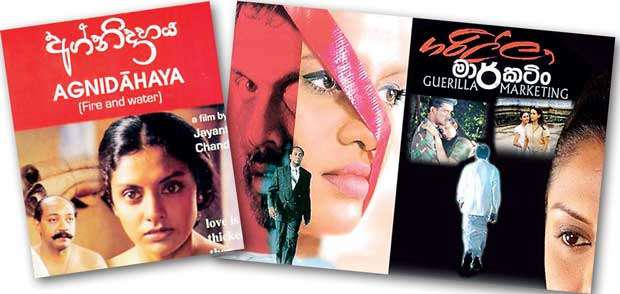Reply To:
Name - Reply Comment
Last Updated : 2024-04-20 00:00:00


 Jayantha Chandrasiri likes to talk, I have always noticed. And how. He can explain and rationalise something that appears to be so portentous and heavy that once he stops talking you are left telling yourself, “Damn, why didn’t I think of that before?”
Jayantha Chandrasiri likes to talk, I have always noticed. And how. He can explain and rationalise something that appears to be so portentous and heavy that once he stops talking you are left telling yourself, “Damn, why didn’t I think of that before?”
At times, though, he can get mysterious, offering explanations for something none of which makes sense or holds the key to the truth.
This latter personality comes up when his films are concerned. That’s natural, and to be welcomed. Directors love revealing threads from the plots of their work and Chandrasiri, being an exception, likes to tackle the eager journalist, writer, or spectator by giving him clues as to what those plots hold.
That, plus the sense of mysticism packed into his films, helps explain why they are so intriguing and why only a very narrow section of the critical fraternity has done justice to them.
This is a review of his latest film, Garasarapa, which I feel deserves full treatment by a worthier critic elsewhere and which, over here, needs to be prefaced by a few thoughts on a director everyone loves to get confused over.
From his first teledrama, Wedahamine, to his most recently screened film, Samanala Sandwaniya, Jayantha is one of the few visual artistes from here whose body of work I’ve watched, re-watched, and pondered over seriously.
What I think about them has a bearing on what I think about Garasarapa, because in more ways than one Garasarapa is to Chandrasiri what, say, Hail Caesar is to the Coen Brothers: it is an inevitable consequence of everything which preceded and prepared us for it. This is true when it comes to his most discernible motif: The intersection of magic and reality, and in the context of our history. Supplanted by romances that never run counter to that motif, it is coloured by dichotomies, which both pit the past against the present and bring them together: Village versus city (Wedahamine), old versus young (Dandubasnamanaya), man versus woman (Akala Sandya).
He was, and is, at his best when he is dwelling on a theme no one without even a smattering of Sri Lankan history can understand. That “history” is Sinhalese and Buddhist, but it is never exclusionist. That his best work ran parallel with the rise of a middle-class Sinhala Buddhist Consciousness, which in turn ran parallel with the rise of an urban nationalist political movement (Think of the Sinhala Urumaya and its successor, the Hela Urumaya), is not, I believe, a coincidence.
When Gamini Akmeemana, in his review, castigated what he felt to be the “middle-class nationalist” outlook of Agnidahaya, Jayantha’s first film, he was contending that it entailed nostalgia for “the mythical and the pastoral.”
In a reply penned just days after the review was published, Malinda Seneviratne, in his own inimitable way, suggested that the people of the 21st century aren’t as rationalistic as Gamini implied them to be, and that the mythical and the magical in Agnidahaya wasn’t as superfluous or unnecessary as “rational” critics described them as being.
Here’s the problem with taking a rational stand on the movies in societies like ours: Once you bring in the concept of cultural identity and heritage, you are bound to alienate a broad section of the population, which has never really understood the workings of that culture.
I don’t think this is a problem with the director. It is a problem with the critic. Agnidahaya, being Jayantha’s first, was slightly overdrawn. Technically and formally, it didn’t stand out: the intersection of love and hatred (the tagline, let’s not forget, was “Vairaya aadarayata vada ganakamai”) between Kamal Addaraarachchi and Jackson Anthony over Yashoda Wimaladharma wasn’t properly sketched out, to mention just one defect.
But most of the critics, particularly from the “cosmopolitan”, “liberal” English press, seemed to ignore that.
The Sunday Times’s R. Wickramasinghe, to give just one example, in a review tellingly titled “Step out of history” suggested that it was wrong of Jayantha to concentrate his entire plot on the year 1664. Forgetting, of course, that much of Jayantha’s forays into our history revolve around the 16th and 17th centuries, near-perfect centuries to delve into considering that they entailed a dichotomy between the reality of colonialism on the one hand and the reality of our cultural presence in the rural hinterlands on the other.
I think the mistake made by the English critic when he or she tries to assess films like Agnidahaya or television serials like Akala Sandya is the confusion that is sustained between magic and reality.
As scholars much more experienced in the field than me will tell you, hundreds of years ago what is considered magic today was treated as a living, breathing reality. And not just in societies like ours.
I can’t tell or ascertain whether Jayantha came to terms with this dilemma ..... but what I and what we do know is that it took a good eight years for him to return to the movies, and when he did return, he made the most atypical work he has ever given
Even in the West, the concept of magic evolved out of a desire to explain what couldn’t be explained, to rationalise what couldn’t be rationalised.
There was hence nothing erratic in Jayantha resorting to the supernatural. Everything -and practically every last detail- has been so well researched that he leaves no room for arbitrary effects. As Akala Sandya, which in this respect is his most “supernatural” work, illustrates, the “concept” of reading and communicating between minds and the power of yogic meditation (let’s not forget time travel) had a definite historical foundation during the reign of Rajasinghe the Second, who ruled at a time when there was an interest in the martial arts (Angampora) and swordsmanship and all the resultant clashes between clans vying for power.
Guerrilla Marketing in that sense was a departure of sorts, though not completely, from what he had been leading up to. This, the most theatrical of all his films (it owes as much to our folk cultural forms, particularly with Premasiri Khemadasa’s music, as it does to the theatre of Beckett and Brecht), also brought to light a basic problem in Jayantha’s universe. I still think Guerrilla Marketing is his best work, and not because I have a penchant towards seeing popular political figures from yesteryear being parodied and rather well at that. (I am, of course, talking about Jackson Anthony’s performance, one of the best performances I’ve seen in a Sri Lankan film.)
I also think that his primary fascination - the rift between what can be explained and what cannot be, or between the mythical and the real - found its way to the director’s depiction of that most contemporary of “magical” devices, advertising. (“Guerrilla Marketing” is a cheap, crude advertising tactic, and the last scene, of our protagonist returning home along a road that has huge cut-outs of the man he “marketed”, is an indictment on the monsters he has released through his own cheap, crude deception.)
It also has some of the best performances that a Jayantha Chandrasiri cast (Kamal, Yashoda, Sriyantha, and of course Jackson, not to mention Sangeetha Weeraratne) could ever have had.
But nevertheless, there was a basic problem. That problem had nothing to do with its plot or themes or cast or even technique. It had to do with the clash which came out between the cultural imperatives of the work and the melodramatic love triangle the work depicted.
Deborah Young’s review of Guerrilla Marketing in Variety is at times off the mark because it fails to account for the richness in Jayantha’s madness (when she indicts those “innovative dance numbers that jump out of nowhere”, she is both paying a compliment to Channa Wijewardena’s choreography and devaluing a key component of the plot, because without those dance numbers, we would not get a sense of proportion, a foundation, through which we can make sense of the link between Gregory Muhandiram’s rabid aversion to culture and his idealisation of mass deception), but where she is correct is where she takes to task what she sees (A little wrongly) as a “silly, star-crossed love triangle” between Thisara (Kamal), his wife Rangi (Sangeetha), and his former lover, who happens to be working at the same ad agency that Rangi and Thisara are, Suramya (Yashoda).
Here, for the first time, we saw a dichotomy arise between two facets Jayantha had brought together before.
I can’t tell or ascertain whether Jayantha came to terms with this dilemma (several reviews, both local and foreign, pointed it out), but what I and what we do know is that it took a good eight years for him to return to the movies, and when he did return, he made the most atypical work he has ever given.
Samanala Sandwaniya is Jayantha Chandrasiri through and through (not least because it has Yashoda as the main actress, and because it induces nostalgia for the past, particularly considering the reference to Gamperaliya through the names of its protagonists), but as Sumitra Peries, who loved it, once told me: “It is Catholic in the sense that it is universal.”
And so it is. Unlike the patently indigene qualities of his previous work, Samanala Sandwaniya is a film for everyone and anyone.
It was a retreat, and a great one at that (though here too, in the form of two buffoonish Laurel-and-Hardy-like jokers who cause a debacle at the park after mocking Yashoda, Jayantha steps out of line thanks to his theatrical past), and without any overt reference to “the mythical and the pastoral”, it could be rationalised by both the liberal and the traditionalist.
Maharaja Gemunu, which followed it, is a film I have unfortunately not seen even now. But what these two works necessitated was a return to Jayantha’s previous oeuvre. Whether Garasarapa resolved the fatal contradiction which Guerrilla Marketing unearthed, whether he finally managed to bring together the historical currents of his plots and the romantic triangle in them, however, are questions I must answer when I delve into my review in my next piece.

Add comment
Comments will be edited (grammar, spelling and slang) and authorized at the discretion of Daily Mirror online. The website also has the right not to publish selected comments.
Reply To:
Name - Reply Comment
On March 26, a couple arriving from Thailand was arrested with 88 live animal
According to villagers from Naula-Moragolla out of 105 families 80 can afford
Is the situation in Sri Lanka so grim that locals harbour hope that they coul
A recent post on social media revealed that three purple-faced langurs near t